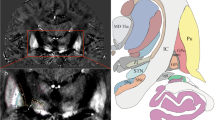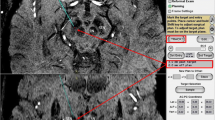Abstract
Purpose
Targeting of the subthalamic nucleus (STN) during deep brain stimulation (DBS) surgery using standard atlas coordinates is used in some centers. Such coordinates are accurate for only a subgroup of patients, and subgroup size depends on the extent of inter-individual variation in STN position/size and degree to which atlas represents average anatomical relations. Few studies have addressed this issue.
Methods
Sixty-two axial T2-weighted magnetic resonance (MR) images of the brain (1.5 T) were obtained before STN-DBS in 62 patients (37 males) with Parkinson’s disease using a protocol optimized for STN visualization. Image distortion was within sub-millimeter range. Midcommissural point (MCP)-derived coordinates of STN borders, STN center, and other brain landmarks were obtained using stereotactic software. MR-derived measurements were compared to Schaltenbrand and Wahren Atlas.
Results
We evaluated 117 best-visualized STNs. STN dimensions and coordinates of its center were highly variable. STN lateral coordinate ranged 8.7 mm–14.5 mm from MCP, A-P coordinate 3.5 mm posterior to 0.5 mm anterior to MCP, and vertical coordinate 1.3 mm–6 mm below MCP. The antero-posterior nucleus dimension varied by 8 mm and lateral-medial dimension by 5.8 mm. Differences between mean values of MR-derived data sets and Atlas values were statistically significant but moderate, excluding AC-PC length, for which the Atlas value was below the 1st percentile of the MR data set. The STN lateral coordinate strongly correlated with the width of the third ventricle (r = 0.73, p < 0.001).
Conclusions
It is now possible to directly evaluate STNs at 1.5 T with minimal image distortion, which reveals variation in STN position and dimensions in the range of nucleus size. This puts under question the rationale of use of standard STN coordinates during DBS surgery.


Similar content being viewed by others
References
Acar F, Miller JP, Berk MC, Anderson G, Burchiel KJ (2007) Safety of anterior commissure-posterior commissure-based target calculation of the subthalamic nucleus in functional stereotactic procedures. Stereotact Funct Neurosurg 85:287–291
Andrade-Souza YM, Schwalb JM, Hamani C, Eltahawy H, Hoque T, Saint-Cyr J, Lozano AM (2005) Comparison of three methods of targeting the subthalamic nucleus for chronic stimulation in Parkinson’s disease. Neurosurgery 56:360–368 discussion 360–368
Ashkan K, Blomstedt P, Zrinzo L, Tisch S, Yousry T, Limousin-Dowsey P, Hariz MI (2007) Variability of the subthalamic nucleus: the case for direct MRI guided targeting. Br J Neurosurg 21:197–200
Bejjani BP, Dormont D, Pidoux B, Yelnik J, Damier P, Arnulf I, Bonnet AM, Marsault C, Agid Y, Philippon J, Cornu P (2000) Bilateral subthalamic stimulation for Parkinson’s disease by using three-dimensional stereotactic magnetic resonance imaging and electrophysiological guidance. J Neurosurg 92:615–625
Breit S, LeBas JF, Koudsie A, Schulz J, Benazzouz A, Pollak P, Benabid AL (2006) Pretargeting for the implantation of stimulation electrodes into the subthalamic nucleus: a comparative study of magnetic resonance imaging and ventriculography. Neurosurgery 58:ONS83–95
Burchiel KJ, Nguyen TT, Coombs BD, Szumoski J (1996) MRI distortion and stereotactic neurosurgery using the Cosman-Roberts-Wells and Leksell frames. Stereotact Funct Neurosurg 66:123–136
Cuny E, Guehl D, Burbaud P, Gross C, Dousset V, Rougier A (2002) Lack of agreement between direct magnetic resonance imaging and statistical determination of a subthalamic target: the role of electrophysiological guidance. J Neurosurg 97:591–597
Funkiewiez A, Ardouin C, Krack P, Fraix V, Van Blercom N, Xie J, Moro E, Benabid AL, Pollak P (2003) Acute psychotropic effects of bilateral subthalamic nucleus stimulation and levodopa in Parkinson’s disease. Mov Disord 18:524–530
Guehl D, Edwards R, Cuny E, Burbaud P, Rougier A, Modolo J, Beuter A (2007) Statistical determination of the optimal subthalamic nucleus stimulation site in patients with Parkinson disease. J Neurosurg 106:101–110
Hamani C, Richter EO, Andrade-Souza Y, Hutchison W, Saint-Cyr JA, Lozano AM (2005) Correspondence of microelectrode mapping with magnetic resonance imaging for subthalamic nucleus procedures. Surg Neurol 63:249–253 discussion 253
Hariz MI (2002) Safety and risk of microelectrode recording in surgery for movement disorders. Stereotact Funct Neurosurg 78:146–157
Hariz MI, Krack P, Melvill R, Jorgensen JV, Hamel W, Hirabayashi H, Lenders M, Wesslen N, Tengvar M, Yousry TA (2003) A quick and universal method for stereotactic visualization of the subthalamic nucleus before and after implantation of deep brain stimulation electrodes. Stereotact Funct Neurosurg 80:96–101
Lanotte MM, Rizzone M, Bergamasco B, Faccani G, Melcarne A, Lopiano L (2002) Deep brain stimulation of the subthalamic nucleus: anatomical, neurophysiological, and outcome correlations with the effects of stimulation. J Neurol Neurosurg Psychiatry 72:53–58
Limousin P, Krack P, Pollak P, Benazzouz A, Ardouin C, Hoffmann D, Benabid AL (1998) Electrical stimulation of the subthalamic nucleus in advanced Parkinson’s disease. N Engl J Med 339:1105–1111
McClelland S 3rd, Ford B, Senatus PB, Winfield LM, Du YE, Pullman SL, Yu Q, Frucht SJ, McKhann GM 2nd, Goodman RR (2005) Subthalamic stimulation for Parkinson disease: determination of electrode location necessary for clinical efficacy. Neurosurg Focus 19:E12
Okun MS, Vitek JL (2004) Lesion therapy for Parkinson’s disease and other movement disorders: update and controversies. Mov Disord 19:375–389
Patel NK, Khan S, Gill SS (2008) Comparison of atlas- and magnetic-resonance-imaging-based stereotactic targeting of the subthalamic nucleus in the surgical treatment of Parkinson’s disease. Stereotact Funct Neurosurg 86:153–161
Richter EO, Hoque T, Halliday W, Lozano AM, Saint-Cyr JA (2004) Determining the position and size of the subthalamic nucleus based on magnetic resonance imaging results in patients with advanced Parkinson disease. J Neurosurg 100:541–546
Saint-Cyr JA, Hoque T, Pereira LC, Dostrovsky JO, Hutchison WD, Mikulis DJ, Abosch A, Sime E, Lang AE, Lozano AM (2002) Localization of clinically effective stimulating electrodes in the human subthalamic nucleus on magnetic resonance imaging. J Neurosurg 97:1152–1166
Schaltenbrand G, Wahren W (1977) Atlas for Stereotaxy of the Human Brain. Stuttgart, Thieme 23–55
Schlaier J, Schoedel P, Lange M, Winkler J, Warnat J, Dorenbeck U, Brawanski A (2005) Reliability of atlas-derived coordinates in deep brain stimulation. Acta Neurochir (Wien) 147:1175–1180 discussion 1180
Schuurman PR, de Bie RM, Majoie CB, Speelman JD, Bosch DA (1999) A prospective comparison between three-dimensional magnetic resonance imaging and ventriculography for target-coordinate determination in frame-based functional stereotactic neurosurgery. J Neurosurg 91:911–914
Starr P, Feiwell R, Marks W Jr (1999) Placement of deep brain stimulators into the subthalamic nucleus: technical approach. Stereotact Funct Neurosurg 72:247
Starr PA, Christine CW, Theodosopoulos PV, Lindsey N, Byrd D, Mosley A, Marks WJ Jr (2002) Implantation of deep brain stimulators into the subthalamic nucleus: technical approach and magnetic resonance imaging-verified lead locations. J Neurosurg 97:370–387
Zhu XL, Hamel W, Schrader B, Weinert D, Hedderich J, Herzog J, Volkmann J, Deuschl G, Muller D, Mehdorn HM (2002) Magnetic resonance imaging-based morphometry and landmark correlation of basal ganglia nuclei. Acta Neurochir (Wien) 144:959–969 discussion 968–959
Zonenshayn M, Rezai AR, Mogilner AY, Beric A, Sterio D, Kelly PJ (2000) Comparison of anatomic and neurophysiological methods for subthalamic nucleus targeting. Neurosurgery 47:282–292 discussion 292–284
Author information
Authors and Affiliations
Corresponding author
Additional information
Comments
The authors have in this well-performed study of 62 patients demonstrated a high variability regarding the localization of the STN, as compared to the standard atlas coordinates. This is in accordance with the findings of previous studies. From these findings it seems as if the standard atlas coordinates of the STN are of very limited value and that surgery should be based on direct visualization of the intended target.
Patric Blomstedt
Umea Sweden
Daniluk et al. assessed the the anatomical position of the STN by means of 1.5-T MRI. They could show a large variability among PD patients regarding the size and shape of the STN. The paper is well written. However, the use of 1.5-T MRI is of some disadvantage in the T2-weighted imaging since it only allows 2-mm slices. It seems to be very "thick" in order to find anatomical structures in a submillimeter space. Therefore, it would be interesting to repeat the study with 3-T MRI and T2 SPACE images.
Jan Vesper
Duesseldorf, Germany
Rights and permissions
About this article
Cite this article
Daniluk, S., G. Davies, K., Ellias, S.A. et al. Assessment of the variability in the anatomical position and size of the subthalamic nucleus among patients with advanced Parkinson’s disease using magnetic resonance imaging. Acta Neurochir 152, 201–210 (2010). https://doi.org/10.1007/s00701-009-0514-z
Received:
Accepted:
Published:
Issue Date:
DOI: https://doi.org/10.1007/s00701-009-0514-z




